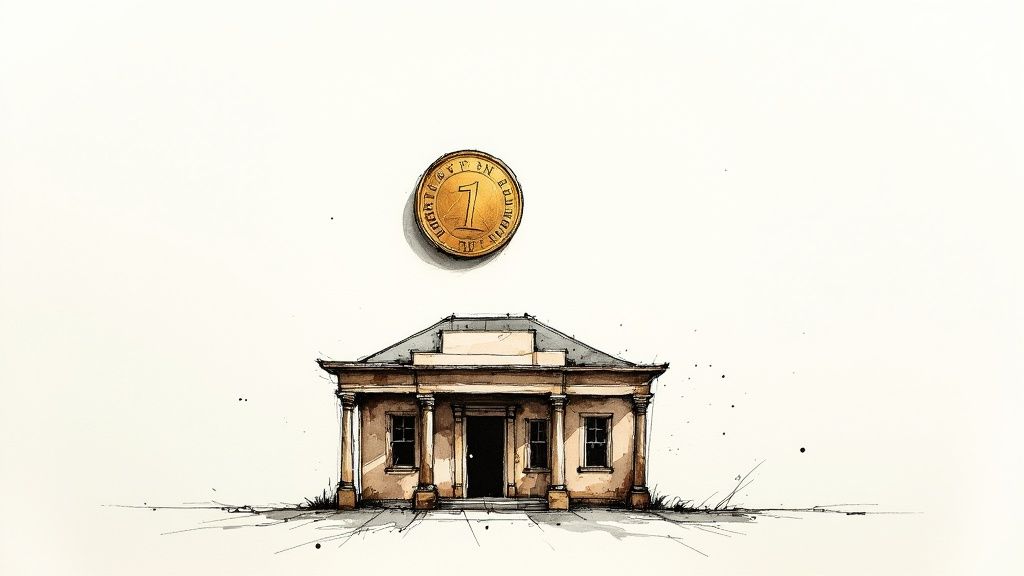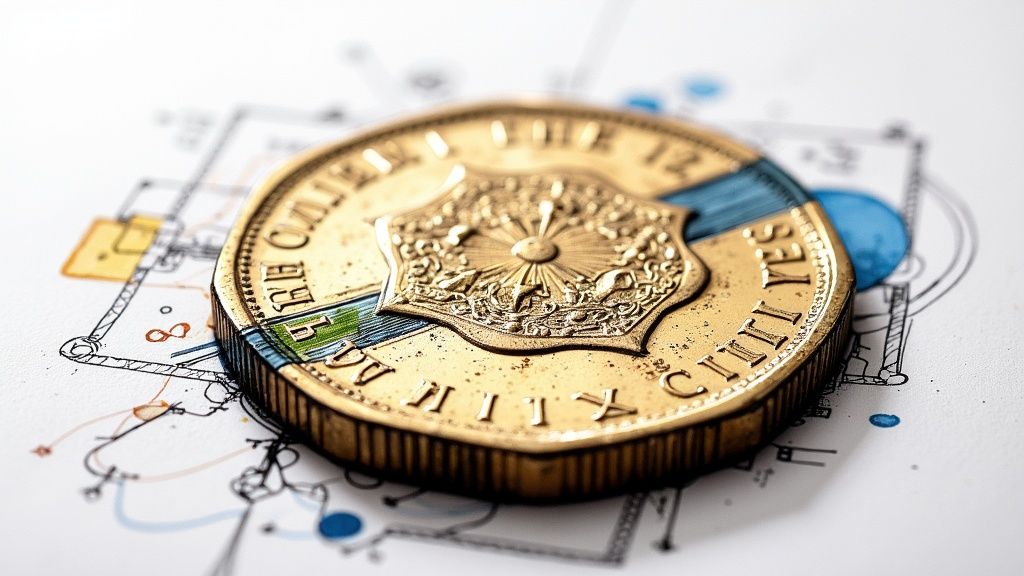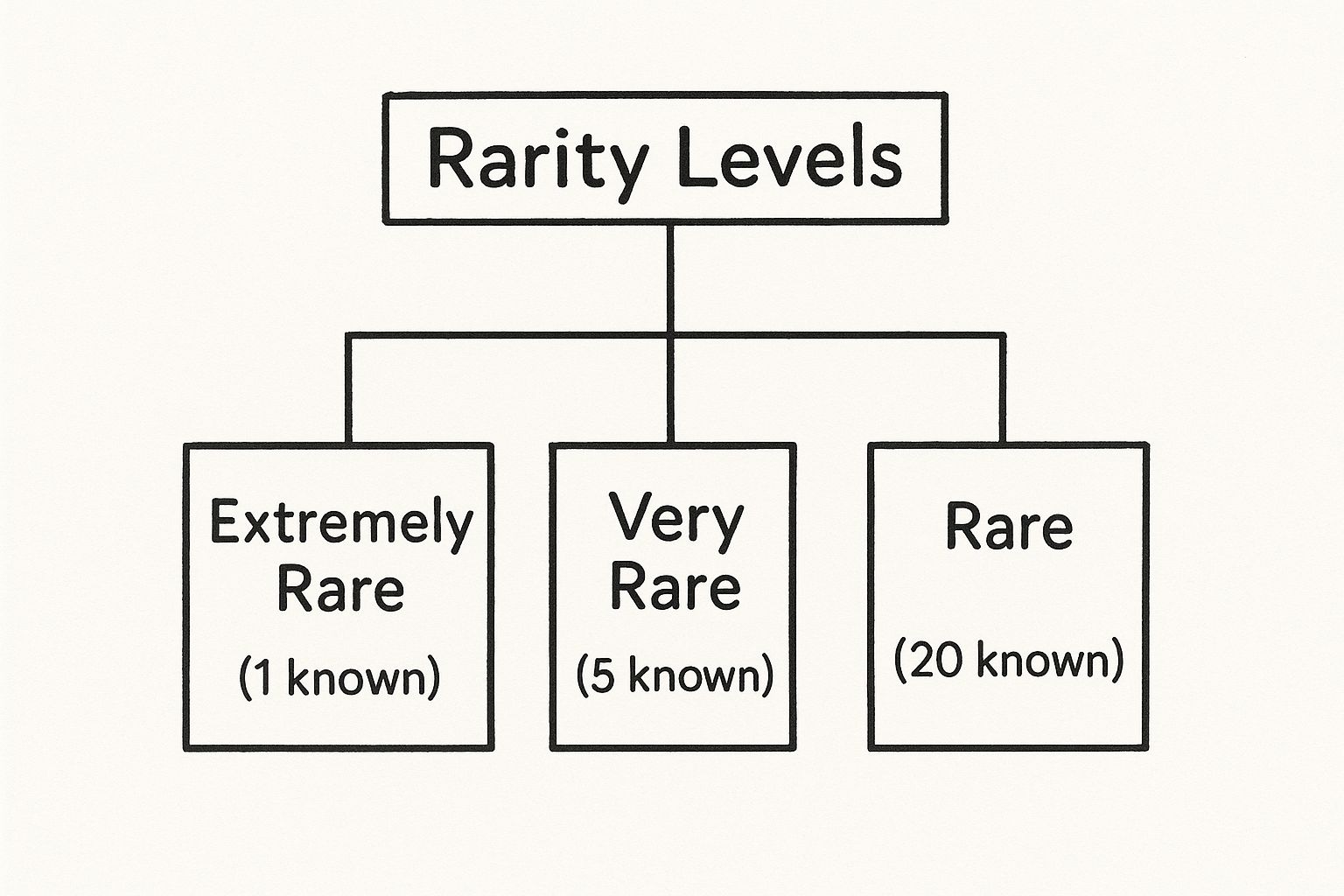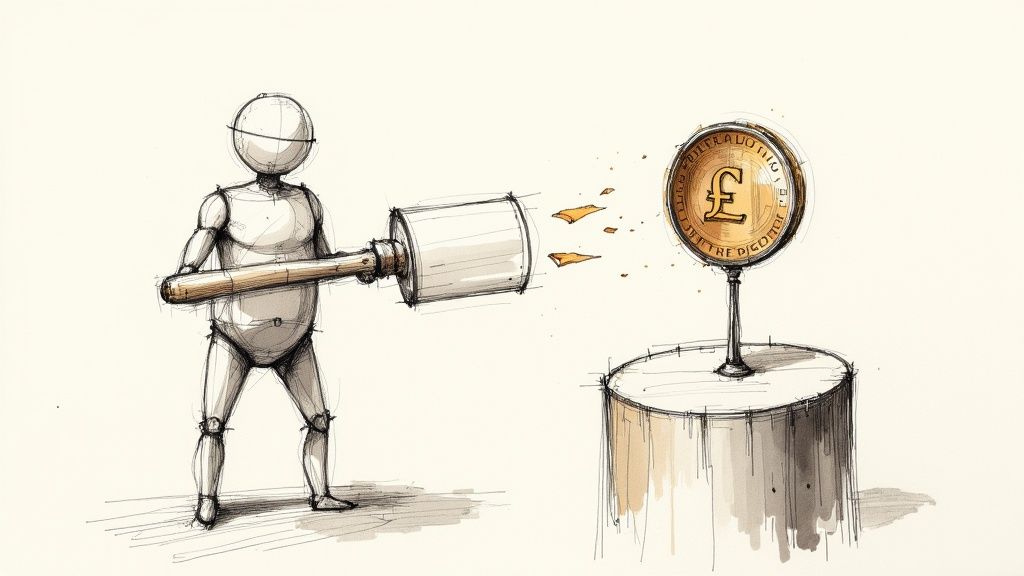If you're checking your change for treasure, the coin you're really hoping to find is the 2011 Edinburgh City £1 coin. Its incredibly low production run makes it the undisputed king for collectors and the ultimate prize to pull from your pocket.
Your Quick Guide to Valuable £1 Coins
When you get into coin collecting, you quickly learn one golden rule: rarity is everything. The fewer coins that were made, the more people want them. It’s simple supply and demand.
This is exactly why certain round £1 coins are worth so much more than their face value. While a few things can make a coin valuable, the biggest factor by far is its mintage figure—that's the official number of coins struck for that specific design and year.
A low mintage instantly makes a coin scarce, turning a humble piece of currency into a genuine collector's item. This guide will walk you through which coins to keep an eye out for and what makes them so special. If you're just starting, our guide on finding valuable one pound coins in your change has some great extra tips.
The Undisputed Champion of Rarity
The 2011 Edinburgh City £1 truly is in a league of its own. Just 935,000 of these coins were ever struck for circulation, making it the only round pound to have a mintage below the one million mark.
That extreme scarcity is what separates it from the rest and puts it at the top of every collector's list. It's not just a coin; it's a piece of modern numismatic history.
The old round pounds featured some beautiful designs representing the different parts of the UK, as you can see below.

This image gives you a good look at the variety of designs that appeared on the round pound between 1983 and 2008, each one a little nod to the nations of the United Kingdom.
To make things easy, here’s a quick summary table of the most sought-after round £1 coins you might find.
Top 5 Rarest UK £1 Coins at a Glance
This table pulls together the key players in the world of rare round pounds. Pay close attention to the mintage figures—they tell you everything you need to know about why these coins are so hard to come by.
| Coin Name/Design | Year of Issue | Mintage Figure | Estimated Value Range |
|---|---|---|---|
| Edinburgh City | 2011 | 935,000 | £15 - £30 |
| Cardiff City | 2011 | 1,615,000 | £10 - £20 |
| London City | 2010 | 2,635,000 | £5 - £10 |
| Royal Arms | 2008 | 3,910,000 | £4 - £8 |
| Belfast City | 2010 | 6,205,000 | £3 - £6 |
As you can see, the Edinburgh coin is far and away the rarest, but the others on this list are certainly worth keeping an eye out for. Happy hunting
Understanding What Makes a £1 Coin Valuable

Ever found yourself staring at a handful of change, wondering why one shiny pound coin might be worth a fortune while another is just... well, a pound? The secret isn’t always about how old a coin is. Far and away, the single biggest factor is its mintage figure – that is, how many were originally made for that specific year and design.
It's a classic case of supply and demand. Think of it like a limited-edition print from a famous artist. If only a thousand are ever made, they’ll be much more sought-after than a poster with millions of copies floating around. The same goes for coins.
A run-of-the-mill £1 coin could have a mintage of over 20 million, so finding one is no big deal. But the rarest pound coins? We're talking mintage figures of less than one million. That simple fact transforms a piece of everyday currency into a genuine collectible.
Beyond Mintage Numbers
While the mintage number is king, it's not the whole story. Other quirks and special circumstances can turn even a common coin into a collector's prize, but you have to know what to look for.
A few key things can seriously ramp up a coin’s scarcity:
- Minting Errors: Sometimes, things go wrong during production. A coin might be struck off-centre, get the wrong inscription stamped on its edge, or even have mismatched sides. These mistakes are usually caught and corrected fast, so the ones that sneak out into circulation are incredibly rare and highly prized.
- Withdrawn Designs: Every now and then, a design is released and then quickly yanked from production. This might happen because of a public outcry, a flaw in the design, or a sudden change in national symbols. The result is a very short production run and an instant collectible.
- Non-Circulating Coins: The Royal Mint doesn't just make coins for our pockets. They also produce special editions for collectors, often in "Brilliant Uncirculated" or "Proof" quality. These are never meant for general circulation, so their numbers are limited from the start, making them a cornerstone of the numismatic market.
Collector's Insight: Getting your head around these rarity factors is what separates a casual change-checker from a serious collector. It’s not just about what the coin is, but why it’s rare.
The Role of Demand in Value
Of course, rarity is only half the equation. For a coin to be truly valuable, people have to actually want it. A coin is only worth what someone is willing to pay, and that's where demand comes in.
The story behind a coin, its artistic merit, or its connection to a big national event can all fuel interest. For instance, designs celebrating the UK’s capital cities often grab more attention than a standard, repeating shield design. It’s this perfect storm – low supply meeting high demand – that creates a truly valuable coin. Once you understand that dynamic, you’re well on your way to spotting the treasures that might just be hiding in your pocket.
Discovering The Rarest Round Pound Coins
Before the sleek 12-sided pound coin landed in our pockets in 2017, the classic ‘round pound’ was a familiar part of British life for over three decades. First minted back in 1983, these coins cycled through a wonderful variety of designs celebrating the rich heritage of the United Kingdom.
While millions upon millions of them were made, a handful were produced in surprisingly small numbers. It’s these low mintage figures that have turned a few specific round pounds into sought-after treasures for collectors today.
This section is your guide to spotting these classic rarities. We'll zero in on the designs that are genuinely scarce, especially the hugely popular Capital Cities series. Knowing which ones are rare—and understanding why—is the first step to finding real value in a pile of old change.
The Capital Cities Series: A Collector Favourite
Of all the brilliant designs that graced the round pound, the Capital Cities series remains a true favourite. Released between 2010 and 2011, this set is famous for one simple reason: it includes some of the scarcest one pound coins ever to enter circulation.
The goal of the series was to capture the unique spirit of London, Belfast, Cardiff, and Edinburgh. But the production numbers for each coin were wildly different, which created a clear pecking order of rarity that collectors now follow religiously.
This handy image helps show how coin experts, or numismatists, think about scarcity. The rarer the coin, the more desirable it becomes.

As the diagram makes clear, the fewer coins known to exist, the higher they climb on the rarity scale. This has a direct knock-on effect on their market value and how badly people want to find them.
A Closer Look At The Top Three Rarities
Let’s get down to the specifics. These are the three coins that every round pound hunter dreams of finding. Their exceptionally low mintage figures put them right at the top of the pyramid.
- The 2011 Edinburgh City £1: This is the undisputed champion of rare round pounds. With a mintage of just 935,000, it's the only circulating round pound ever to have a production run under one million. The design proudly features the city’s official coat of arms.
- The 2011 Cardiff City £1: Coming in at a close second, the Cardiff coin had a mintage of 1,615,000. It also displays the city’s coat of arms and is a fantastic find, although there are over half a million more of these in existence compared to its Scottish counterpart.
- The 2010 London City £1: Representing the nation’s capital with the emblem of the City of London, this coin had a mintage of 2,635,000. While it’s certainly more common than the 2011 pair, it is still considered a scarce and valuable piece.
The table below breaks down the mintage figures for the complete Capital Cities series, making it easy to see why the Edinburgh and Cardiff coins are in a league of their own.
Rarity Ranking of the UK Capital Cities £1 Series
| Capital City | Year | Mintage Figure | Relative Scarcity |
|---|---|---|---|
| Edinburgh | 2011 | 935,000 | Extremely Rare |
| Cardiff | 2011 | 1,615,000 | Very Rare |
| London | 2010 | 2,635,000 | Scarce |
| Belfast | 2010 | 6,205,000 | Common in this series |
As you can see, the Belfast coin was produced in far greater numbers, making it much easier to find. The real hunt is for those top two.
Of course, rarity isn't just about low mintages. Sometimes, mistakes during production can create unique and valuable oddities. If that sparks your interest, you can read our guide to discover valuable error coins and their hidden treasures.
A Collector's Tip: When you're checking Capital Cities coins, the date is everything. The 2011 issues for Edinburgh and Cardiff are the ones you're really looking for. They command the highest prices purely because so few were made.
While other round pounds like the 2008 Royal Arms and some of the Floral Emblem designs are worth holding onto, it’s the Capital Cities series—and the Edinburgh coin in particular—that remains the pinnacle for collectors of modern British coins.
Spotting the Rare Modern 12-Sided £1 Coins
When the high-tech, 12-sided £1 coin arrived in 2017, it wasn't just the end of the road for the old 'round pound'—it kicked off a brand-new treasure hunt for collectors. While we all know about the classic round pound rarities, the modern bimetallic coins have quickly started to produce their own hidden gems. Your pocket change is once again a hunting ground.
Many of these new rarities are born out of unique moments, like major national events or transitional periods at The Royal Mint. It’s during these times that production runs for certain dates or designs can be surprisingly low, creating instant collectibles the moment they're struck. Getting your head around these details is the secret to spotting the rarest one pound coins of the modern era.
One of the first things to get straight is the difference between a coin’s mintage date (the year stamped on it) and its circulation date (when it was actually released). It’s a common mistake to assume they’re always the same, but that’s often not the case at all.
Key Collector Insight: The Royal Mint sometimes produces coins dated for one year but holds them back, releasing them much later—if at all. This delay can create an artificial scarcity, making a coin that looks brand new incredibly hard to find in circulation.
Monarch Changes and Mintage Surprises
Nothing shakes up the coin world like a change of monarch. The recent transition from Queen Elizabeth II to King Charles III has already created some fascinating modern rarities. Coins struck during these pivotal years are often made in much smaller numbers as the mint pauses and adjusts its production schedules.
After the round pound was phased out, certain 12-sided £1 coins quickly gained a reputation for being scarce, particularly those from these transitional years. For instance, the 2022-dated £1 coins are some of the very last to feature Queen Elizabeth II’s portrait. Their numbers are tiny compared to the millions of other pounds in circulation. You can learn more about how these periods create sought-after coins by exploring The Royal Mint's analysis on rare circulating £1 coins.
Potential Future Rarities to Keep an Eye On
It’s not all about the official mintage figures. Sharp-eyed collectors know to look for errors and variations. Although The Royal Mint's quality control is top-notch, mistakes do happen, and these slip-ups can create incredibly valuable oddities.
For the 12-sided pound, here’s what you should be looking for:
- Die Errors: These are tiny flaws in the die used to strike the coin, like small cracks or chips. They show up as little raised lines or blobs of metal on the finished coin.
- Rotational Errors: This is when the obverse (the King's or Queen’s head) isn’t perfectly lined up with the reverse (the design). If the rotation is significant, it can make a coin very desirable to collectors.
- Transitional Errors: We all remember the famous undated 20p 'mule' from the round coin era. While similar errors are theoretically possible with the modern £1 coin, they are extremely unlikely, making them a holy grail find.
You’ll need a keen eye to spot these subtle flaws, but finding one can turn an ordinary pound coin into a serious discovery. With new designs released every year, every single coin that passes through your hands is another chance to find the next great modern rarity.
How to Authentate and Value Your Coins

That thrill of finding a potentially rare coin is just the beginning of the journey. What comes next is crucial: you have to verify it's the real deal and then accurately figure out its condition. These two steps are what separate a true collector's piece from just another bit of pocket change.
Counterfeiting was a massive problem for the old round pound – in fact, that's a big reason why they were replaced. A study back in 2011 found that fakes were alarmingly common in some samples. This history just goes to show why you absolutely have to authenticate any potential find. You can explore the background of £1 coin circulation on Wikipedia to get the full story.
Spotting a Fake Pound Coin
The good news is, you don't need to be a professional numismatist to run some basic checks. With a little practice, you can learn to spot the tell-tale signs of a counterfeit round pound.
Grab a magnifying glass if you have one and take a close look at these specific areas:
- Edge Inscription: On a genuine coin, the lettering around the edge is sharp, clear, and perfectly spaced. Fakes often have inscriptions that are blurry, mushy, or even have spelling mistakes.
- Portrait Details: Focus on the Queen’s portrait. A real coin will have incredibly fine, crisp details in her hair and the crown. Counterfeits just can't replicate this, and the details often look soft or poorly defined.
- Overall Quality: A genuine coin just feels right. It has a consistent colour and a professional finish. Many fakes look cheaply made, with a strange colour, an uneven surface, or a sloppy alignment between the front and back.
A Quick Authentication Tip: One of the simplest yet most effective checks is to compare the date with the edge inscription. Each design was paired with a specific inscription for that year. If they don't match, you're almost certainly looking at a fake.
Understanding Coin Condition and Grading
Once you're happy that your coin is genuine, its value is almost entirely down to its condition, or what collectors call its grade. A perfect, untouched coin that looks like it just left the mint can be worth many, many times more than the exact same coin that's been scratched and worn down by years in circulation.
The grading system is simply a standardised way to describe a coin’s state of preservation. While the full system can get quite complex, the basic levels are pretty straightforward:
- Uncirculated (UNC): This is a perfect coin. It has absolutely no signs of wear and looks as fresh as the day it was minted.
- Extremely Fine (EF): You can see the tiniest hints of wear, but only on the very highest points of the design. Most of its original mint lustre is still there.
- Very Fine (VF): The coin has clearly been in circulation and shows minor wear on the details, but it's still a sharp and good-looking piece.
- Fine (F) and Below: At this point, significant wear is obvious across the whole coin, and many of the finer details have been worn smooth.
Pinpointing the exact grade can be subjective, which is why professional grading services are so important for serious collectors. If you think you've found a real gem, getting it professionally graded is the next step. Our detailed guide explains how to get coins graded by professionals.
Ultimately, seeking a valuation from a reputable dealer or auction house is the best way to understand the true market value of your rarest one pound coin.
Common Questions About Rare Pound Coins
As you dip your toes into the fascinating world of coin collecting, it’s completely natural for questions to pop up. Think of this section as your friendly guide, answering some of the most common queries to help you build a solid foundation and hunt for treasure with confidence.
Which Is the Absolute Rarest Pound Coin?
The undisputed champion, the one coin every collector hopes to find in their change, is the 2011 Edinburgh City £1. It’s in a league of its own.
Why? It all comes down to the mintage figures. Only 935,000 of these coins were ever produced for circulation, making it the only round pound to have a mintage below the one million mark.
The other coins in the Capital Cities series are scarce, but they just don't compare.
- The 2011 Cardiff City £1 had a mintage of 1,615,000.
- The 2010 London City £1 saw 2,635,000 enter circulation.
Those numbers really put it into perspective. The Edinburgh design is the ultimate prize for a reason—its unique scarcity makes it incredibly sought-after.
Are Error Coins Valuable?
Absolutely. A significant mistake during the minting process can turn an ordinary, everyday coin into something exceptionally valuable.
These errors are usually caught quickly at the Royal Mint, so only a tiny number ever escape into the wild. It’s this rarity that can send their value soaring.
Keep an eye out for oddities like:
- Mules: A very rare error where a coin is struck with dies from two different designs – for example, the head of one coin and the tail of another.
- Off-Centre Strikes: This happens when the coin isn't lined up properly, and the design appears noticeably off-centre.
- Incorrect Edge Inscriptions: The writing around the edge might be wrong for that year, or in some cases, even upside down.
A classic example is the small number of 2016 transitional £1 coins that were accidentally struck with the wrong date. A find like that is often unique or one of only a handful in existence, making it a top prize for specialist collectors. The value really depends on the specific error and just how rare it is.
How Does Coin Condition Affect Value?
The condition, or "grade," of a coin is one of the most critical factors in determining what it's worth. A rare coin in perfect, uncirculated condition can sell for many, many times more than the exact same coin that's been rattling around in pockets and tills for years.
A rare coin is like a classic car. One that's been kept in a garage and perfectly preserved is worth a fortune. The same model with dents, rust, and high mileage is worth a fraction of the price, even if it's just as rare.
Collectors use a grading scale to describe a coin's condition, ranging from 'Poor' all the way up to 'Uncirculated' (UNC) or the even more pristine 'Proof' condition. An uncirculated 2011 Edinburgh £1, for example, might sell for over £30. A heavily worn one, however, might only fetch a few quid over its face value.
This is exactly why it's so important to handle any potentially rare finds with care. Preserving their condition means preserving their value.
What Is the Best Way to Sell a Rare Coin?
If you’re lucky enough to have a rare pound coin on your hands, you’ve got a few good options. The best choice really depends on the coin's value and how hands-on you want to be.
Online marketplaces like eBay are incredibly popular and give you access to a massive global audience of collectors. To succeed here, you’ll need to take high-quality photos, write a clear and accurate description, and be mindful of the seller fees.
For coins that are especially rare or valuable, going through a reputable auction house or a specialist coin dealer is often a safer and more profitable route. They can professionally authenticate and grade your coin, which builds trust with serious buyers and often leads to a higher selling price (though they will take a commission).
Finally, don’t overlook coin collecting forums and local clubs. They can be excellent places to connect directly with knowledgeable and trustworthy buyers.
At Cavalier Coins Ltd, we are passionate about helping both new and experienced numismatists build their collections. Whether you are looking for that specific rare coin or want to explore world banknotes, our extensive selection has something for everyone. Visit our store to discover your next treasure.

